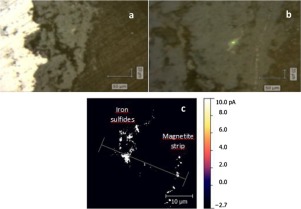当前位置:
X-MOL 学术
›
Corros. Sci.
›
论文详情
Our official English website, www.x-mol.net, welcomes your
feedback! (Note: you will need to create a separate account there.)
Electrical properties of iron corrosion layers formed in anoxic environments at the nanometer scale
Corrosion Science ( IF 7.4 ) Pub Date : 2018-06-01 , DOI: 10.1016/j.corsci.2018.03.028 Florence Mercier-Bion , Jiaying Li , Hélène Lotz , Ludovic Tortech , Delphine Neff , Philippe Dillmann
Corrosion Science ( IF 7.4 ) Pub Date : 2018-06-01 , DOI: 10.1016/j.corsci.2018.03.028 Florence Mercier-Bion , Jiaying Li , Hélène Lotz , Ludovic Tortech , Delphine Neff , Philippe Dillmann

|
Abstract The electrical properties of the corrosion layers on archaeological iron artefacts were determined by Conductive Atomic Force Microscopy. Different corrosion products were studied: FeII carbonates, magnetite entrapped in the carbonate, and iron sulfides. The results indicate that the ferrous carbonate matrix is insulating, and that magnetite and iron sulfides have a conductive character, although these phases are not systematically connected to the metal. This suggests that electrons produced by the anodic dissolution of metal would be conducted to the external part of the corrosion product layer through a three-dimensional network of connected magnetite strips passing through the ferrous carbonate matrix.
中文翻译:

纳米尺度缺氧环境中形成的铁腐蚀层的电学特性
摘要 用导电原子力显微镜测定考古铁制品腐蚀层的电学性质。研究了不同的腐蚀产物:FeII 碳酸盐、碳酸盐中夹带的磁铁矿和硫化铁。结果表明碳酸亚铁基体是绝缘的,磁铁矿和硫化铁具有导电特性,尽管这些相没有系统地连接到金属上。这表明金属阳极溶解产生的电子将通过穿过碳酸亚铁基体的连接磁铁矿条的三维网络传导到腐蚀产物层的外部。
更新日期:2018-06-01
中文翻译:

纳米尺度缺氧环境中形成的铁腐蚀层的电学特性
摘要 用导电原子力显微镜测定考古铁制品腐蚀层的电学性质。研究了不同的腐蚀产物:FeII 碳酸盐、碳酸盐中夹带的磁铁矿和硫化铁。结果表明碳酸亚铁基体是绝缘的,磁铁矿和硫化铁具有导电特性,尽管这些相没有系统地连接到金属上。这表明金属阳极溶解产生的电子将通过穿过碳酸亚铁基体的连接磁铁矿条的三维网络传导到腐蚀产物层的外部。











































 京公网安备 11010802027423号
京公网安备 11010802027423号